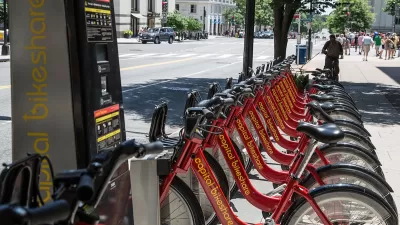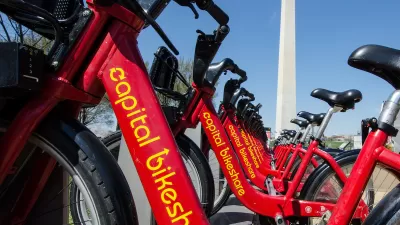The wildly popular system ‘frays at its geographic edges,’ making its use less effective outside the central District.

The Washington, D.C.-area Capital Bikeshare (CaBi) system is seeing record-breaking ridership, with the number of rides jumping almost 50 percent between October 2023 and October 2024.
According to a piece in Greater Greater Washington by David Meyer, “The growth is driven in part by local governments’ investment in new e-bikes, which began to make up a majority of CaBi rides in August. Members, who are more likely to be local, account for 66.6% of all rides—a sign of the system’s utility as a go-to commuting and transportation source for locals, not tourists.”
However, Meyer points out that the system still has some “regional deficiencies,” making some parts of the network more aesthetic than useful. “In DC, Mayor Muriel Bowser has pledged to put a bikeshare station within a quarter-mile of every resident’s home, a promise not matched by local lawmakers in many other parts of the region. As a result, walkable communities outside the District often lack the requisite CaBi station density required to make bikeshare a viable transportation option.”
Meyer suggests that CaBi should take a hard look at its governance model and perhaps take a more regional approach to strengthening the entire system and ensuring there are enough stations and bikes to serve outlying areas. Bringing CaBi under the umbrella of the regional transit agency could have advantages: “Treating CaBi as public transit could transform it from an amenity to a necessity in parts of the region where bikeshare doesn’t perform well at the moment.” However, it could also make the system more vulnerable to transit funding cuts.
FULL STORY: CaBi is a huge success. Will the program structure allow it to keep growing regionally?

Trump Administration Could Effectively End Housing Voucher Program
Federal officials are eyeing major cuts to the Section 8 program that helps millions of low-income households pay rent.

Planetizen Federal Action Tracker
A weekly monitor of how Trump’s orders and actions are impacting planners and planning in America.

Ken Jennings Launches Transit Web Series
The Jeopardy champ wants you to ride public transit.

Washington Legislature Passes Rent Increase Cap
A bill that caps rent increases at 7 percent plus inflation is headed to the governor’s desk.

From Planning to Action: How LA County Is Rethinking Climate Resilience
Chief Sustainability Officer Rita Kampalath outlines the County’s shift from planning to implementation in its climate resilience efforts, emphasizing cross-departmental coordination, updated recovery strategies, and the need for flexible funding.

New Mexico Aging Department Commits to Helping Seniors Age ‘In Place’ and ‘Autonomously’ in New Draft Plan
As New Mexico’s population of seniors continues to grow, the state’s aging department is proposing expanded initiatives to help seniors maintain their autonomy while also supporting family caregivers.
Urban Design for Planners 1: Software Tools
This six-course series explores essential urban design concepts using open source software and equips planners with the tools they need to participate fully in the urban design process.
Planning for Universal Design
Learn the tools for implementing Universal Design in planning regulations.
Heyer Gruel & Associates PA
Ada County Highway District
Institute for Housing and Urban Development Studies (IHS)
City of Grandview
Harvard GSD Executive Education
Toledo-Lucas County Plan Commissions
Salt Lake City
NYU Wagner Graduate School of Public Service





























